- Accueil
- Base de données
- 35
- 31 August 1944
31 August 1944
Handley Page Halifax B Mk III (MZ879 code BM-O)
Off Saint-Malo (35)
(contributors : Thierry Trotin, Olivier Brichet, Lt Col A. Dhillon, Claude Archambault, Daniel Dahiot, Jean-Michel Martin)

© artwork Jean-Marie Guillou

Handley Page Halifax Mark III
© UK Government, domaine public - Source www.raf.mod.uk

Crew (no 433 Squadron) :
- Flying Officer (pilot) James Ralph BEVERIDGE (service number J/26756), 26 years old. RCAF
Panel 245. RUNNYMEDE MEMORIAL
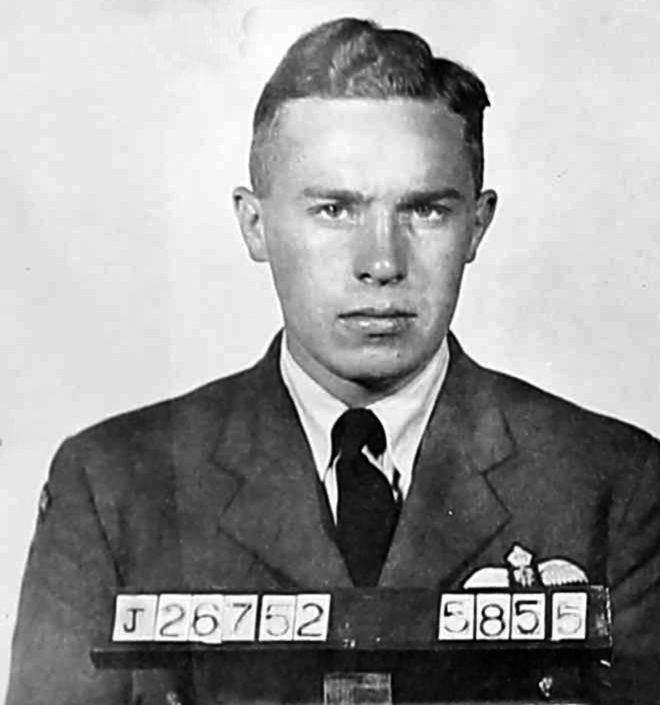
© Photo courtesy of Shirley Stone
- Sergeant (flight engineer) Charles William GARRETT (service number 1896238), 36 years old, RAF Volunteer Reserve
Panel 229. RUNNYMEDE MEMORIAL

© Photo courtesy of Shirley Stone
- Pilot Officer (navigator) Frederic Cuthbert HARMAN (service number J/89312), 31 years old, RCAF
Panel 250. RUNNYMEDE MEMORIAL

© Photo courtesy of Shirley Stone
- Pilot Officer (air bomber) Wendell Lyall LONG (service number T/89159), 21 years old, RCAF
Panel 251. RUNNYMEDE MEMORIAL

© Photo courtesy of Shirley Stone
- Pilot Officer (wireless operator - air gunner) Lorne Stanley GUERNSEY (service number J/86188), 25 years old, RCAF
Panel 250. RUNNYMEDE MEMORIAL

Lorne Stanley GUERNSEY © Photo courtesy of the Guernsey - Smith family

© Photo courtesy of Shirley Stone
- Pilot Officer (air gunner) George William PHARIS (service number J/95167), 29 years old, RCAF
Panel 252. RUNNYMEDE MEMORIAL

© Photo courtesy of Shirley Stone
- Pilot Officer (air gunner) James Reid HAWKINS (service number J/95166), 20 years, RCAF
Panel 250. RUNNYMEDE MEMORIAL
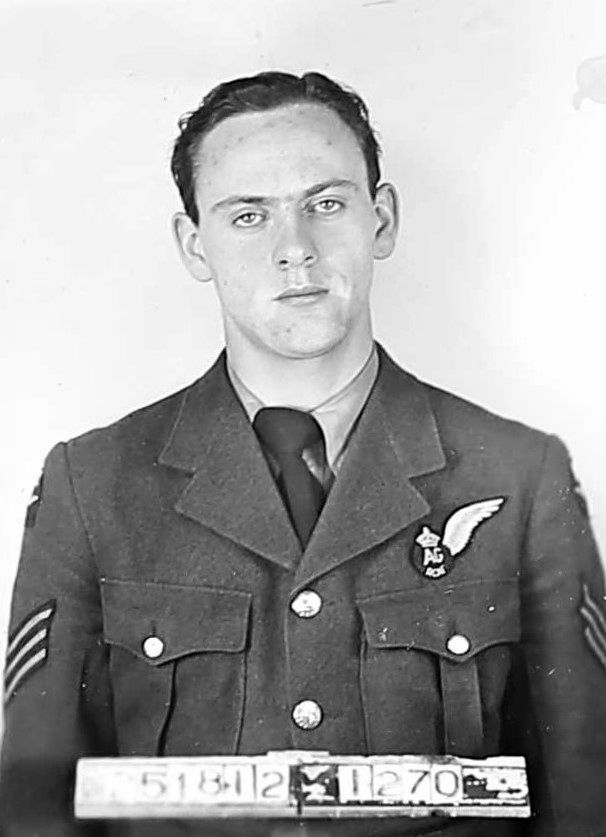
© Photo courtesy of Shirley Stone
THE STORY
From 1942, the Germans fortified the "Isle de Cézembre". Heavy guns prevent allied ships from entering the bay of Saint-Malo. The Isle also has powerful anti-aircraft defense. Commanded by Oberleutnant Richard Seuss, it is occupied by nearly 400 men : German sailors, Russian, Italian and Polish soldiers.
On August 6, 1944, the American army arrived in Saint-Malo via road 137... On August 17, after several days of deadly fighting and numerous destructions, the Germans, who occupied the corsair city, capitulated. The Isle of Cézembre is the last bastion that resists. For the Americans, the destruction of this position is essential so that they can use the harbors of Granville, Cancale and Saint-Malo for the delivery of equipment and provisions which are vital to them.
The idea of a landing was quickly rejected because it would be very costly in human lives. A systematic shelling by land artillery, supported by aviation which drops explosive, incendiary phosphorus or napalm bombs, was prefered. Cézembre received his orders from Jersey, commanded by Vice Admiral Hüffmeier, a fervent Nazi who zealously applies the führer's instructions : resist to the allies in order to delay their progress towards Germany. Richard Seuss therefore refused to capitulate... As a consequence, the American command decided to annihilate the garrison with 380 mm shells from the British battleship Malaya. Despite this “iron flood”, no white flag appears…
Thursday August 31 marks the peak of this hell. Late in the morning, 165 Halifax bombers attack the Island. The weather is nice and the sky is clear. Five Mosquito "Pathfinders" from Squadrons 105 and 109 (see appendices) were sent to mark the targets, thus allowing the four-engine aircrafts to drop their bombs (one of the five Mosquitos did not carry out any marking). The bomber group flies 3,000 feet above the target and carries out a fairly concentrated bombing run. A photo reconnaissance Mosquito from Squadron 627 accompanies the raid (see appendices) which allowed to observe a very concentrated bombardment.

Photo taken by a Mosquito of no 627 SQN after the raid.
Source : Operation Record Book SQN 627 - National Archives
The recently liberated "Malouins" (people from Saint-Malo) gathered in the Sillon to watch the “show” ! After four long years spent under the yoke of the Germans, they were not unhappy to see the occupiers subjected to bombings. 15 Canadian aircrafts from Squadron 433 took part in this raid. The Halifax "If any" (MZ879), piloted by James Ralph Beveridge, had just dropped her bombs when she was hit by the Flak. She quickly lost altitude and headed towards the "Pointe de la Varde", under the anxious gaze of people from Saint-Malo. The aircraft was too low for the crew to bail out. Beveridge and his co-pilot decided to attempt a water landing by getting as close as possible to the "Pointe de la Varde". The aircraft hit the water surface suddenly, broke up and quickly sank. The sea was low and many witnesses joined the beach to rescue any survivors. The aircraft disappeared, none of the seven crew members were able to leave, their bodies were never found. The flight engineer, Charles William Garrett, was the only Englishman on the crew, aged 36 ; he was over the legal age to fly. He was probably forced to insist on circumventing R.A.F. regulations. The youngest, James Reid Hawkins, the upper gunner, was only 20 years old. George William Pharis, the rear gunner, had already lost his brother in November 1943, whose aircraft had crashed. Two days later, the "Isle de Cézembre" finally capitulated...
These 165 bombers were distributed as follows :

THE CREW OF THE HANDLEY PAGE HALIFAX "IF ANY"

The crew of the Handley Page Halifax "If Any".
Standing, left to right : C.W. GARRETT, unknown, F.C. HARMAN, J.R. HAWKINS, W.L. LONG
Crouching, left to right : J.R. BEVERIDGE, L.S. GUERNSEY
G.W. PHARIS is not on the photo.
- James Ralph BEVERIDGE was 26 years old. He was the son of John Ferdinand and Catharine Beveridge, of London, Ontario (Canada). Born on April 17, 1918 in Colwyn Bay, Wales (Great Britain), he arrived in Canada at the age of 3. His father had served in World War I. The family lived in Ontario, in Hamilton and then in London. James was educated in Ontario and the United States and later worked as an aeronautical inspector for De Havilland Aircraft Limited in Toronto. He had a brother, John Cyril Beverage, who served as a Lieutenant in the Royal Canadian Navy. He enlisted on April 6, 1942 in Hamilton. He was not married but was engaged to Miss E. Allen who lived in Nottinghamshire, England. James R. Beveridge's interests and hobbies included engineering, photography, woodworking, and oil painting. His sports: cricket, baseball, skiing, rifle and revolver shooting.
- Charles William GARRETT was 36 years old (born in 1908). He was the son of Andrew and Louise Garrett, and the husband of Kathleen D. Garrett, West Dulwich, London.
- Frederic Cuthbert HARMAN was born on September 3rd, 1912 and was 31 years old. He was the son of Harold Frederic Harman and stepson of Marion H. Harman, of Victoria, British Columbia (Canada). He lived in Winnipeg, Manitoba, where he went to school. He completed 4 years of high school at Kelvin High School in Winnipeg. Then he worked for the Bank of Montreal in Vancouver, British Columbia, in various positions, including accounting. He enlisted on June 30, 1942 in Vancouver. He was not married. His interests and hobbies were marine equipment and mechanical work, stamp collecting, hunting and fishing. His sports: golf, tennis, basketball and hockey.
- Wendell Lyall LONG was born on May 31st, 1923 and was 21 years old. He was the adopted son of Jack and Irene Long, of Chemainus, British Columbia (Canada). He was born in 1923 in Michigan in the United States. He had a sister who was also adopted. He lived in British Columbia, Canada. He went to school for 12 years and then worked as a millwright, mechanic and welder. He enlisted on June 13, 1942 in Vancouver.
- Lorne Stanley GUERNSEY was born on Januaru 2, 1919. He was 25 years old. He was the son of Stanley M. and Rose H. Guernsey of Kenora, Ontario, Canada. Lorne S. Guernsey went to school in Kenora. Before the war, he was in turn an apprentice mechanic, a truck driver, then an aeronautical inspector. He enlisted on September 14, 1941 in Kenora. His interests were singing and acting, and his sports were hockey and football. He was not married and, to our knowledge, had no brothers or sisters.

Photo via Shirley Stone
- George William PHARIS, born on September 11, 1914, was 29 years old. He was the son of Leslie E. and Marie B. Pharis, of Magrath, Alberta, Canada. He was not married. His brother, Flying Officer Hampton Blaine Pharis, was killed on 13 November 1943 aboard a Sunderland seaplane of No. 423 Squadron which crashed following engine problems during an anti-submarine patrol. He had a sister who became a famous author and playwright. He helped on the family farm and worked as a mechanic and automobile engineer. He loved playing chess. His sports were boxing, badminton, swimming and baseball. He enlisted on December 12, 1942 in Lethbridge, Alberta..
- James Reid HAWKINS born in 1924, was 20 years old. He was the son of James and Josephine Hawkins of Toronto, Ontario, Canada, where he lived and went to school. He worked as an office clerk for the Liquor Control Board of Ontario. He was not married and had 3 sisters. His interests were drawing and his sports were hockey, boxing, basketball and football.

Photo via Shirley Stone
THE WRECK FOUND 74 YEARS LATER
With a very succinct Squadron report, the solution to locate the crash point of this aircraft was to find witnesses. In 1998, a call for witnesses was launched and eight people responded. It was very moving to read these letters written by elderly people who were teenagers at the time. They all saw the bomber fall into the sea, but the versions differed... Olivier Brichet and Thierry Trotin then determined a fairly large search area : a rectangle measuring 1 km by 2.
Then they explored the area with a depth sounder but without success. Like other aircrafts wrecks in the region, the bomber was certainly broken up. Our divers then opt for a much more random method : drift dives... For 20 years, they carried out more than 40 dives, carried by the currents... On June 30, 2018, Yann Ecolan, a Saint-Malo diver, revealed a new clue : the GPS position of a three-blade propeller. While diving, our divers identified a Hamilton Standard propeller, a propeller that was fitted to the Halifax bombers. It lied alone, on a rocky drop-off, probably moved by professional fishermen. The position of this propeller indicated a latitude ; by cross-checking it with the testimonies of the time, the research was therefore oriented to the East of this point. On July 11, several drift dives were carried out and during the last one, an isolated piece of wing was discovered. Thierry Trotin returned to the scene with Vincent Colleu, pushing the sensitivity of the sounder, and they obtain several small echoes. Underwater, they discovered the bomber's four engines and numerous debris lying on a muddy bottom, covered with crepidula. The plane suffered greatly from storms and fishermen's dredges. Thierry Trotin formally identified the aircraft by finding a “swinging liner”, characteristic of the Bristol Hercules engines which equipped the Halifax.

The swinging liner found on site, typical of a Halifax engine..
Photo collection Brichet and Trotin
It seems that the fishermen knew about this wreck, as did the Saint-Malo firefighters, who found a propeller in the 1980s.
Olivier Brichet and Thierry Trotin shared their discovery with Rolland Mazurié de Garenne, then president of "Souvenir Français de Saint-Malo", who organized a commemoration at sea on August 31, 2019 (see below). As a tribute to the missing crew members, our divers placed a commemorative plaque on the site, on one of the engines of the Halifax.
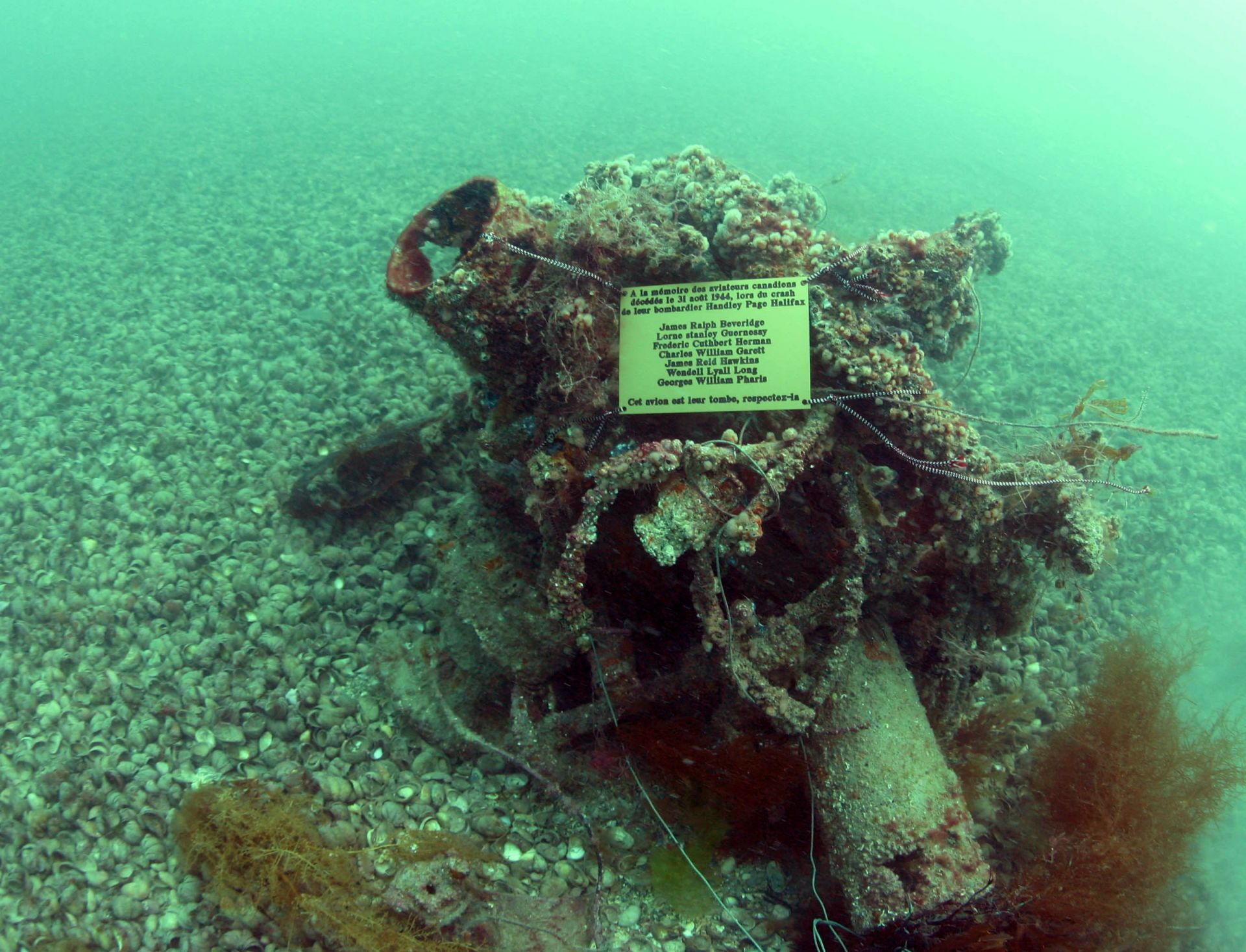
The commemorative plaque placed on the wreck of the Halifax. The text states :
"In memory of the Canadian airmen who died on August 31, 1944, during the crash of their Handley Page Halifax bomber
James Ralph Beveridge
Lorne Stanley Guernsey
Frederic Cuthbert Herman
Charles William Garrett
James Reid Hawkins
Wendell Lyall Long
George William Pharis
This aircraft is their grave, respect it."
Photo collection Brichet and Trotin
Below are the magnificent photos of their dives.

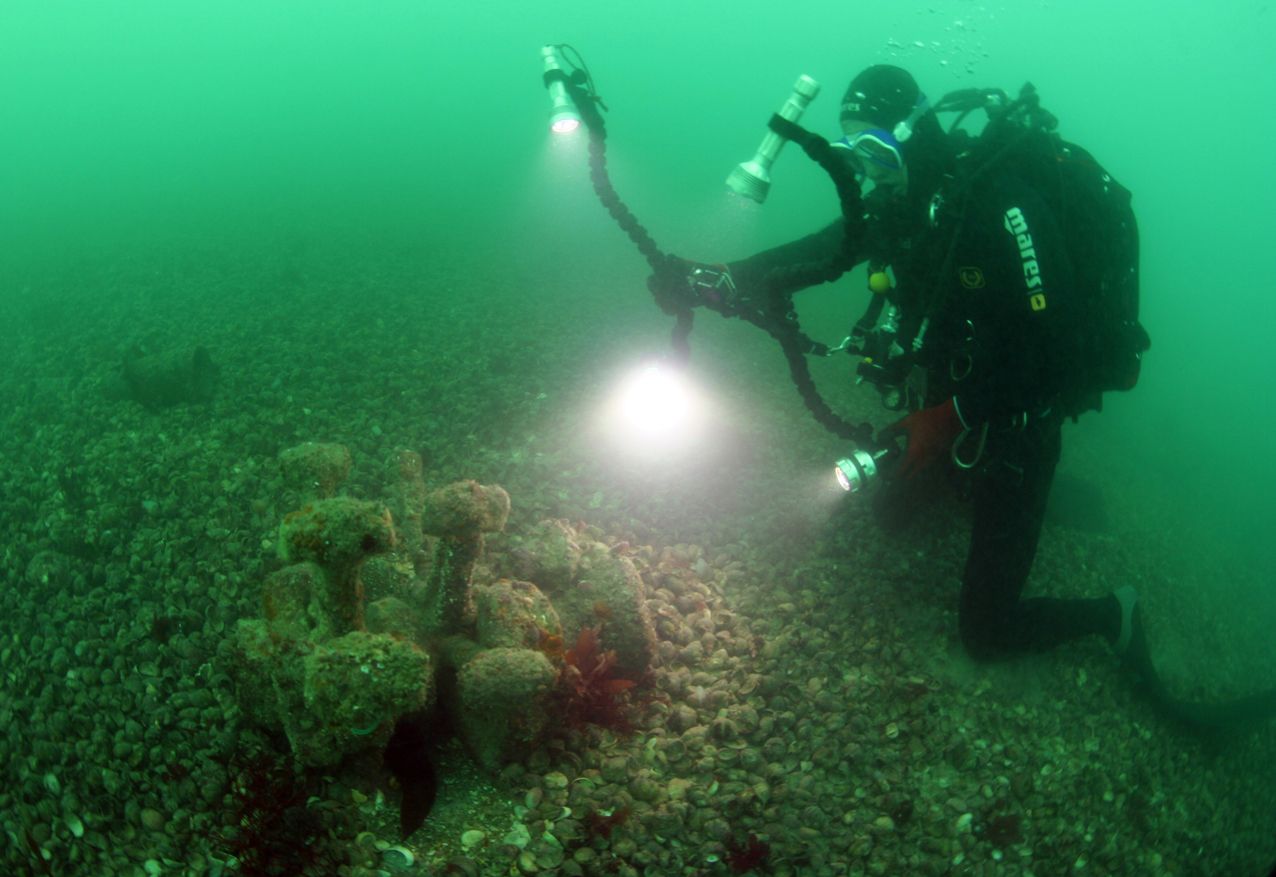
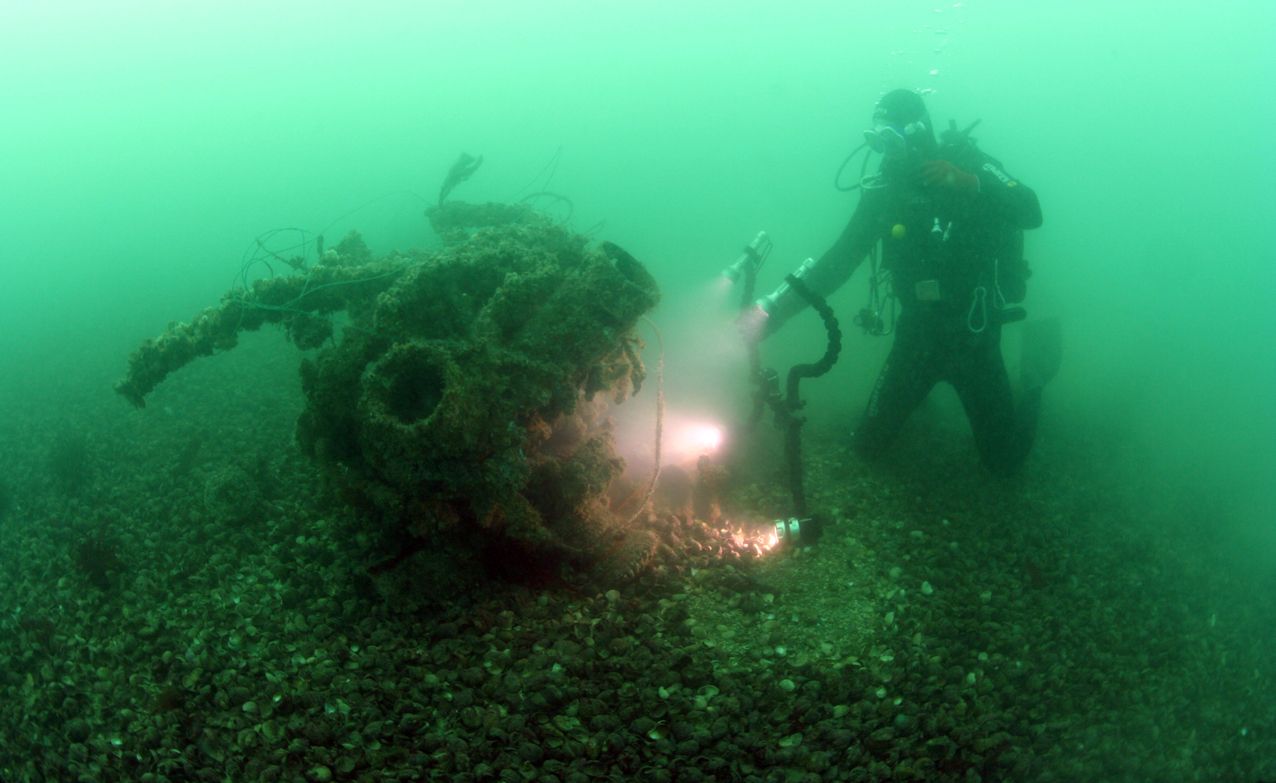



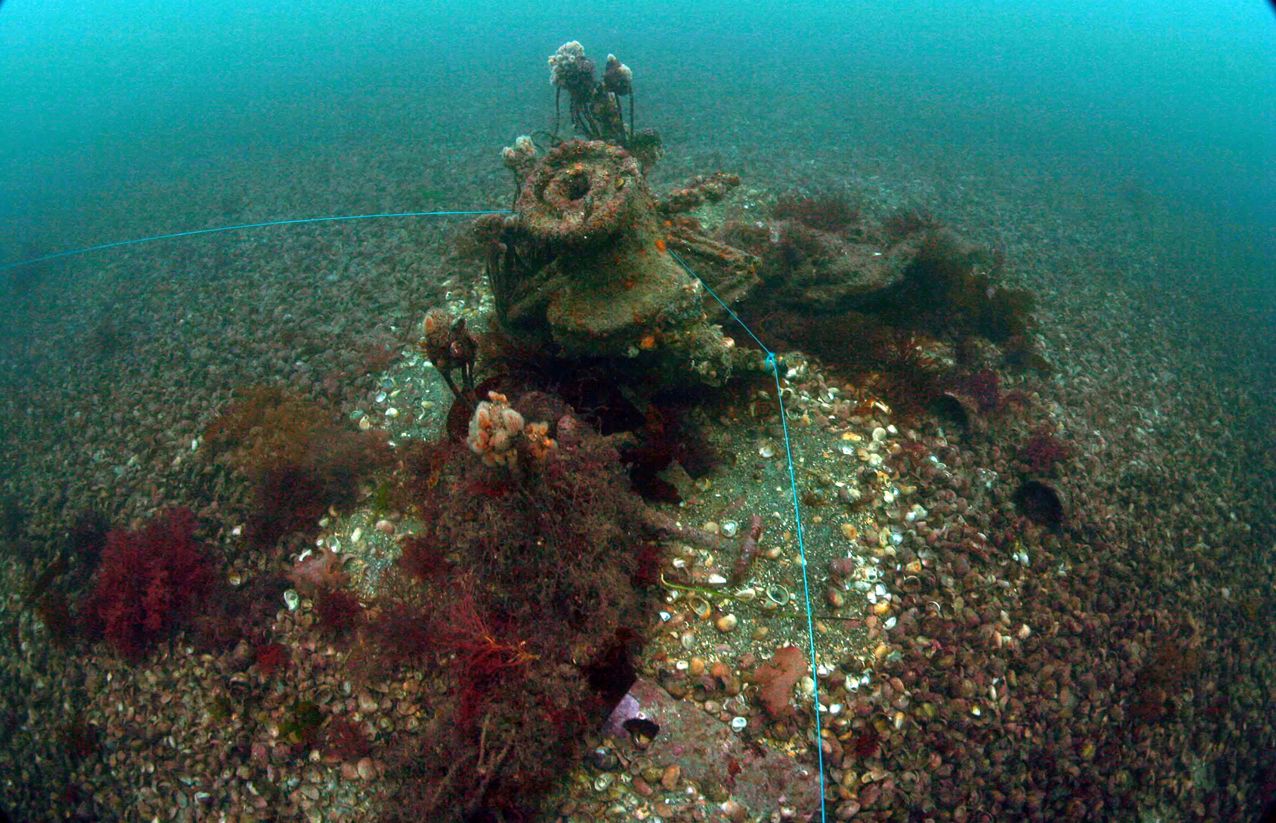






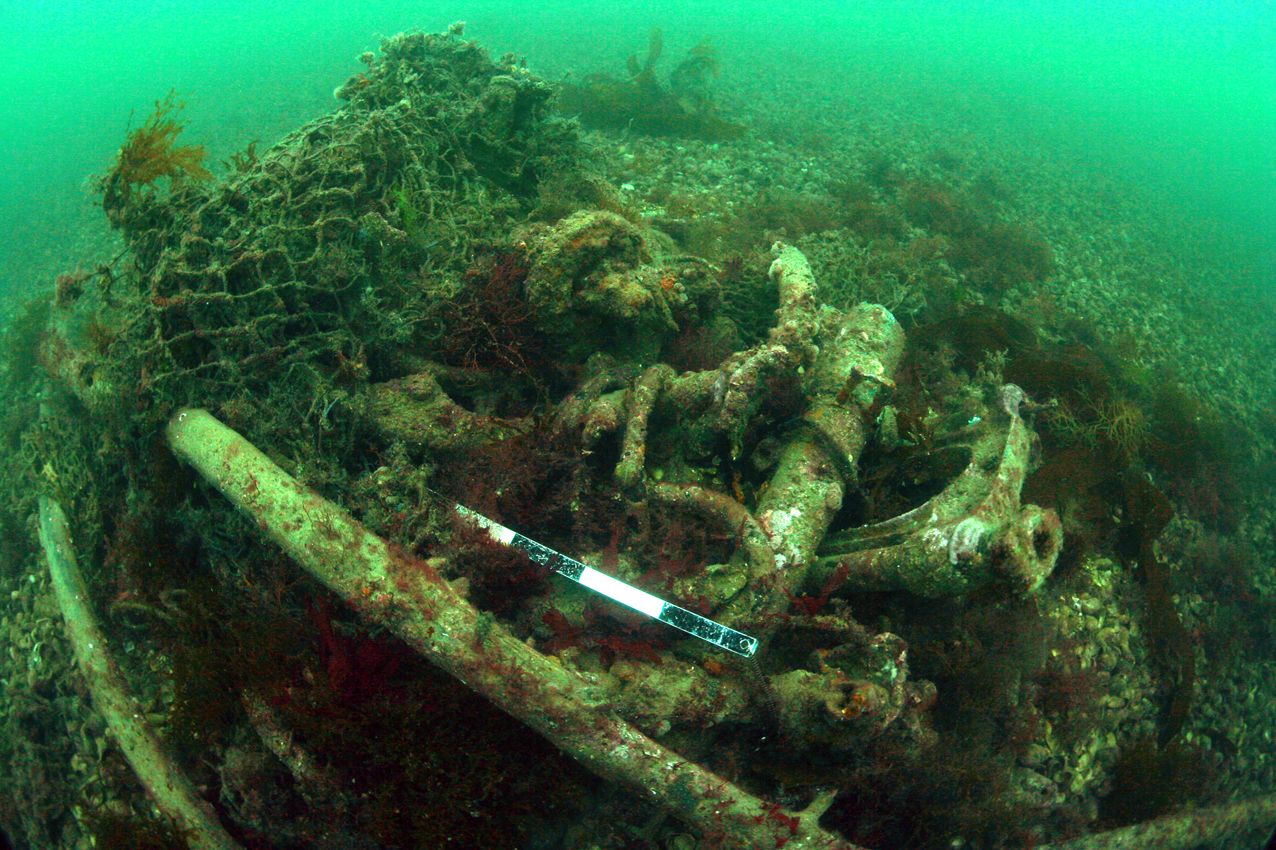


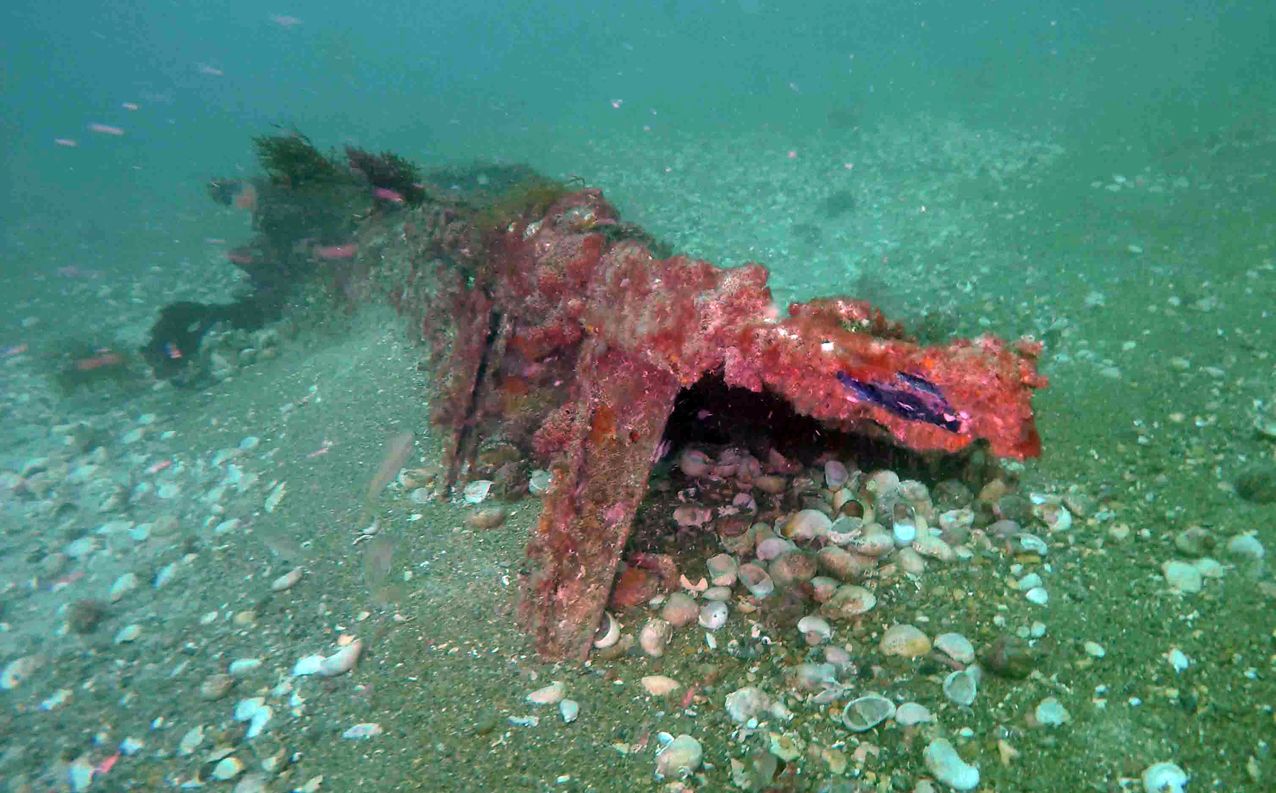


Photos collection Brichet and Trotin
IN MEMORIAM
♦ "Second World War Book of Remembrance"
(source : The Canadian Virtual War Memorial)
- page 249 : James Ralph Beveridge

- page 328 : Frederic Cuthbert Harman

- page 368 : Wendell Lyall Long

- page 323 : Lorne Stanley Guernsey

- page 416 : George William Pharis
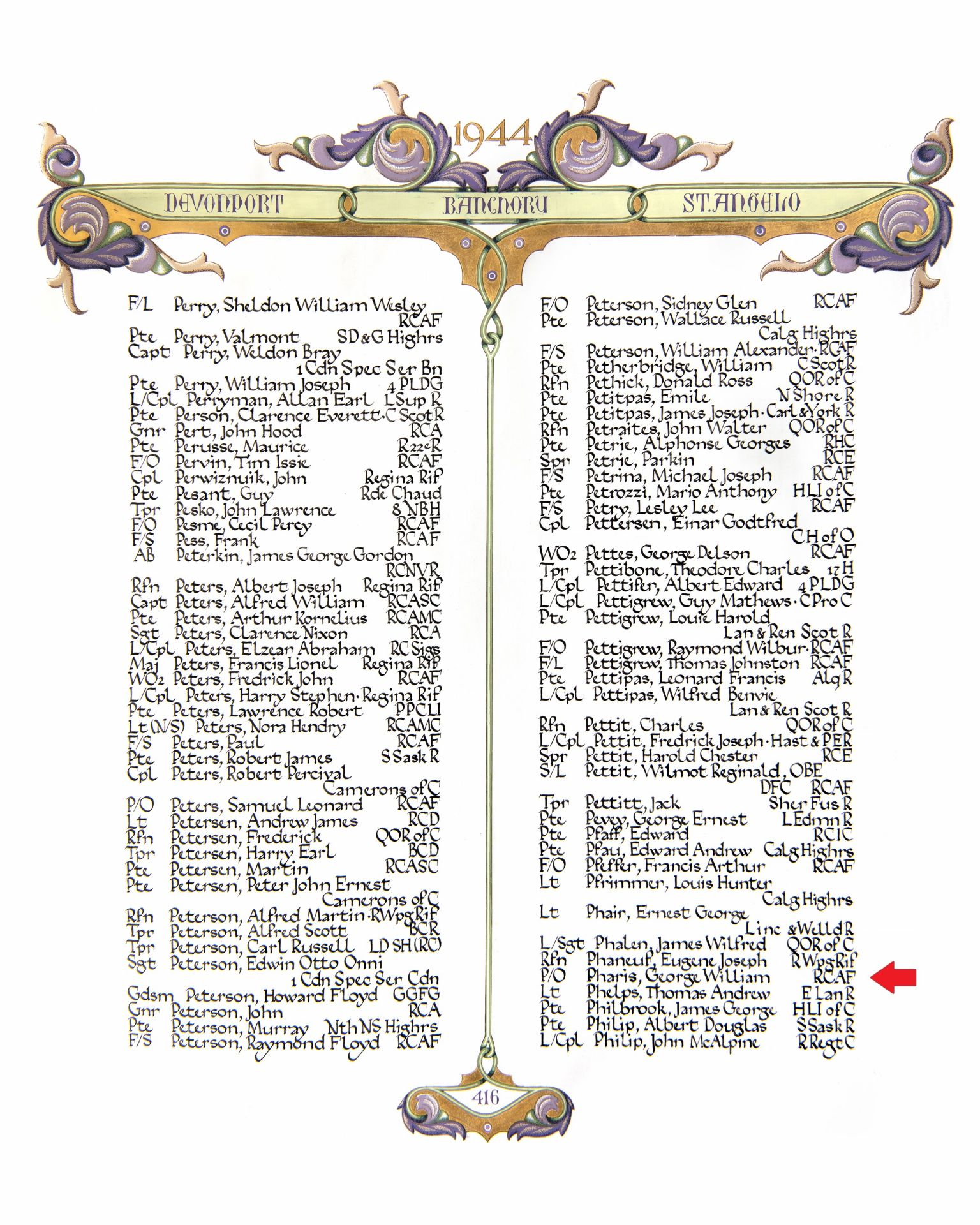
- page 331 : James Reid Hawkins

APPENDICES
♦ 31 August, 2019 : 75th anniversary !
That day, Olivier Brichet and Thierry Trotin, accompanied by Thierry's son, took with them a photo montage made by Shirley Stone, a Canadian whose help was invaluable in collecting information on the crew, and decided to return a moving tribute to the crew. They went to the sea, to the crash site, aboard a motorboat, to lay seven flowers.

The souvenir panel made by Shirley Stone, a Canadian who helped Olivier and Thierry in their remembrance process.
Photo collection Brichet-Trotin & Shirley Stone
On site, Olivier Brichet, his heart filled with emotion, read these few words :
« 75 years ago, on August 31, 1944, after bombing the 'Isle de Cézembre', the Handley Page Halifax MZ879 crashed into the sea at this location.
The crash was so violent that all the crew members perished: The pilot, James Ralph Beveridge, the co-pilot, Lorne Stanley Guernesay, the navigator, Frederic Cuthbert Herman, the upper gunner, James Reid Hawkins who was only 20 years old, the air bomber, Wendell Lyall Long, the rear gunner, George William Pharis and the flight engineer, Charles William Garett, the only British member of the crew. We are thinking of his daughter Kathleen who lost her dad, as well as the families of the other crew members.
We must never forget these men, volunteers, who died to free our country from the yoke of the Nazi occupiers. The wreckage of this plane remains their shroud for eternity. »
We let you discover below the photos of this moving moment.

Olivier Brichet presents the souvenir panel of the 75th anniversary of the disappearance of the crew.
Photo collection Brichet-Trotin

Thierry Trotin in turn presents the souvenir panel in memory of the crew.
Photo collection Brichet-Trotin

Gabriel Trotin, son of Thierry, also wanted to pay tribute to the crew.
Photo collection Brichet-Trotin

Olivier Brichet and Thierry Trotin pay tribute to the crew of the Handley Page Halifax "If any".
Photo collection Brichet-Trotin

Thierry Trotin lays roses at the Handley Page Halifax "If any" crash site.
Photo collection Brichet-Trotin


The roses float for a while as if to mark the moment.
Photos collection Brichet-Trotin
APPENDICES
(source of documents : The National Archives unless otherwise specified)
♦ Operational Record Book of Squadron 433 for the date August 31, 1944
- mission summary

The text framed in red indicates for the date August 31, 1944
"Fine, 2/10ths clouds, fresh wind from NE, visibility good. Daylight operations were laid on and fifteen A/C took off to participate in an attack on a heavy gun emplacement, situated on a small island just off the coast at St. Malo, France. The weather was good with good visibility. The crews attacked from the low level of 3,000 feet. No enemy opposition was encountered at the target but the two channel islands, Jersey and Alderney gave a small amount of trouble. The bombing was accurate and good results were achieved. A/C "O", captained by J26756 F/O J.R. Berveridge, failed to return from this operation."
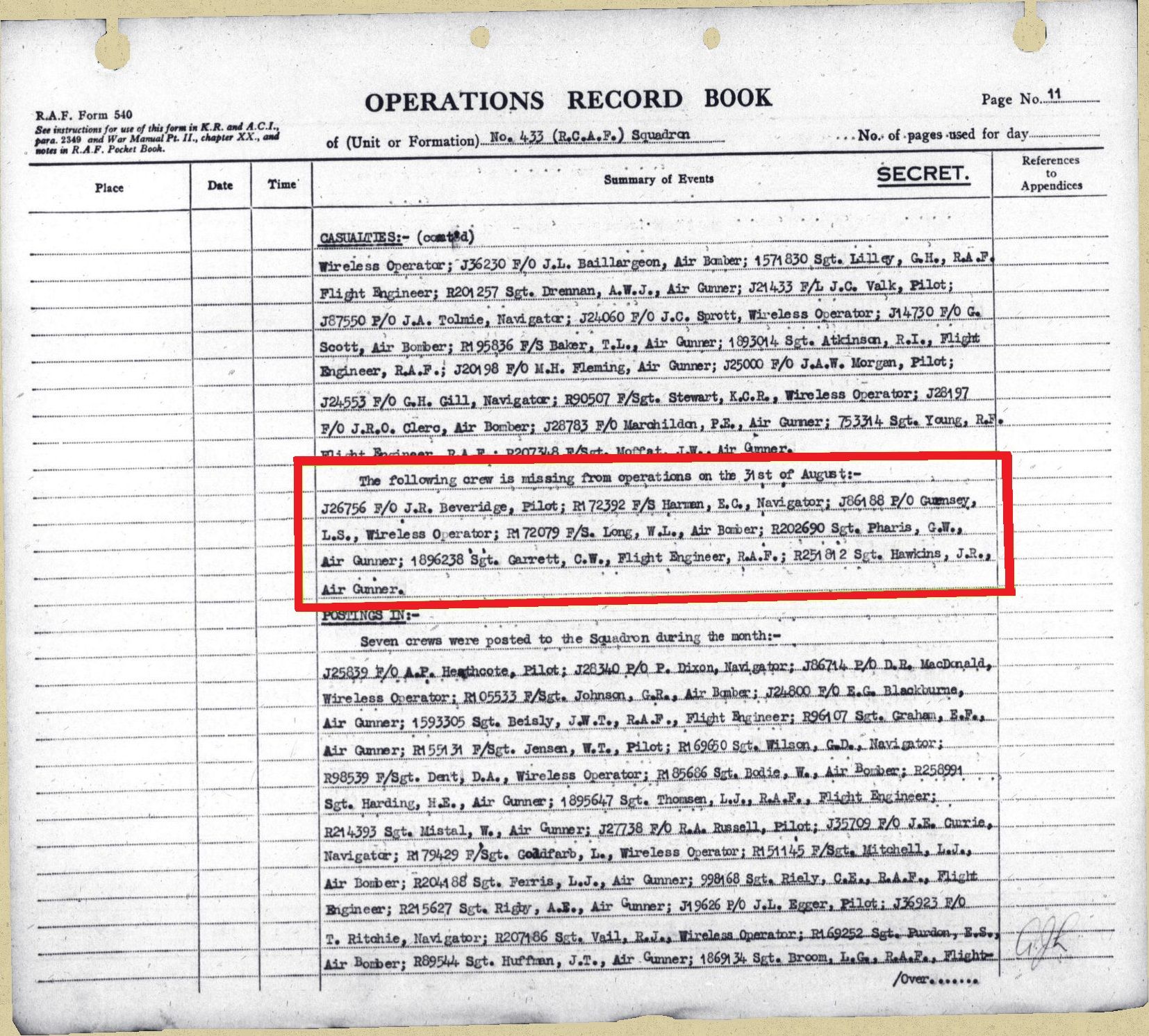
Document provided by Lieutenant Colonel Aaron Dhillon (RCAF)
The text framed in red gives the list of members of the crew missing from the mission of August 31, 1944, specifying their service number.

Document provided by Lieutenant Colonel Aaron Dhillon (RCAF)
The text framed in red indicates that aircraft "O", commanded by Flying Officer Beveridge, took off at 10:36 a.m. but failed to return from the mission.
- List of the 15 Halifax bombers from Squadron 433 engaged in the mission with their crews. The "If any" is 10th on the list (red box).
The 15 aircrafts are :




♦ Operational Record Book of Squadron 105 for the date August 31, 1944
- mission summary

The text indicates
"St. Malo, the Isle de Cezembre, was again attacked by Bomber Command. 2/3 of our aircraft marked for 164/165 Halifaxes. The attack took place from 1,200 to 3,000 feet, because of the low cloud. An excellent concentration developed resulting in many explosions."
- the 3 Mosquitos of the "Pathfinder Force" engaged in the mission :

* Distinguished Flying Cross

♦ Operational Record Book of Squadron 109 for the date August 31, 1944
Two Mosquitos Mk IX were sent to mark the targets. The first one (ML907) indicated that he marked the "ILE D'EZEMBRE" (Isle of Cézembre) from an altitude of 32,000 feet with A.R. 5513 (Automatic Release Navigational Aids Oboe : a target marking system). Cloud density was 5/10. The second one (LR510) indicated having marked the target also with A.R. 5513 but from an altitude of 22,000 feet. Cloud coverage was 10/10 at 10,000 feet.


♦ Operational Record Book of Squadron 627 for the date August 31, 1944
A Mosquito Mk XX (number KB 215) was sent to make a photo reconnaissance of the bombing. Piloted by Flying Officer M.D. GRIBBIN, accompanied by the navigator Flying Officer P.G. HERBERT, it took off at 11:40 a.m. and returned to base at 2:45 p.m.
The comment indicates :
"Target : ISLE DE CEZEMBRE. Photos taken from 13.04/13.20 hrs., from 3 000/800 ft. Raid seemed very concentrated ; only a few bombs fell in the sea towards the end of the attack.
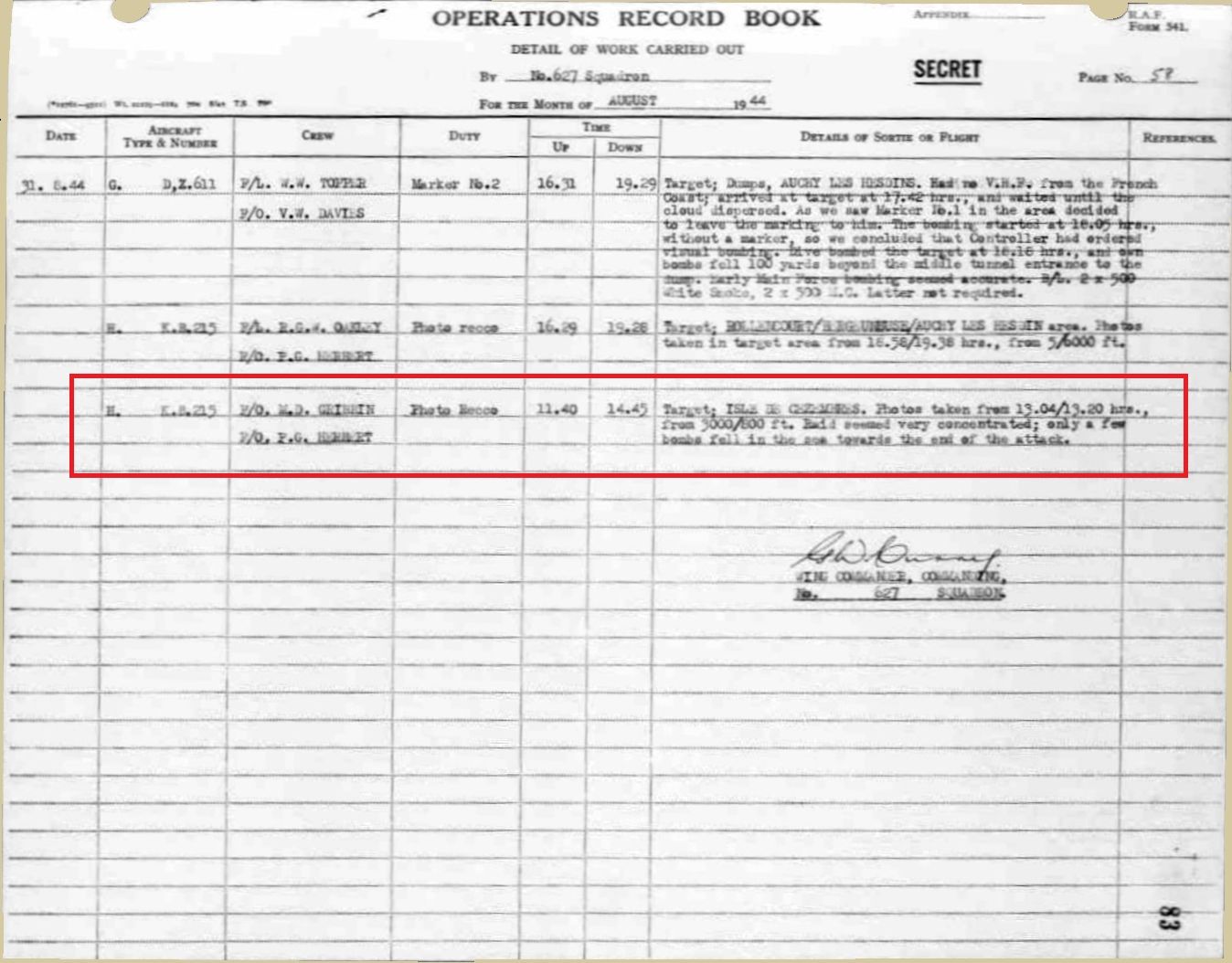
A photo of this reconnaissance mission is preserved in the archives with the following comment :
"One crew carried out a photo-recco. of the attack on Coastal Battery, on the Isle de Cezembre. The target was successfully photographied for 15 minutes. Attack appeared very concentrated except for a few bombs which fell in the sea at the end of the attack, and the island was obscured by smoke and dust clouds."

♦ Operational Record Book of the RCAF no C-12434 for the date August 31, 1944
(Source Canadiana Heritage)

This document summarizes the mission as follows :
Ile de Cezembre 171 a/c (aircrafts) were disptached
Group Squadron Aircraft
6 (see below) 165 Halifax
5 627 1 Mosquito
8 105, 109 5 Mosquitoes
169 (including 1 missing) are reported to have attacked the Coastal Batteries with 800.2 tons HE and 1.8 tons IB. 1 sorite was abortiv and the Mosquito of 5 Group completed a Photo Recce. of the target.
RCAF PARTICPATION
No. 6 RCAF Group dispatched the following Halifaxes :
408-15, 415-15, 420-15, 425-15, 426-15, 427-14, 429-16, 431-15, 432-15, 433-15, 434-15.
The 165 Halifaxes (including 1 missing) are reported to have attacked the primary target with 799.1 tons HE and 1.8 tons IB.
We therefore find the information communicated at the beginning of this page with some confirmation and clarifications :
- we have confirmation that an aircraft aborted the mission. According to RAF ORBs, it is Mosquito no ML996 of No. 105 Squadron.
- 169 planes (165 Halifax + 4 Mosquitos therefore attacked the island and 1 other Mosquito photographed it after the raid.
- our Halifax MZ879 accomplished her mission before being unfortunately shot down.
- the details concern the bomb loads dropped that day :
- 800.2 tonnes of HE (High Explosive) bombs were carried that day and 799.1 tonnes dropped
- 1.8 tonnes IB (Incendiary Bomb) bombs were carried and dropped.

Ajouter un commentaire